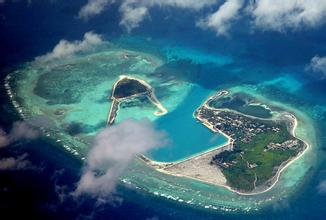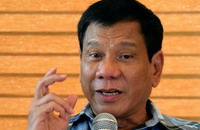Might the rush to arbitration be nothing more than a US provocation to provide an excuse for military engagement? asks Shannon Ezra
The most effective way to halt China's global rise is to exert control over its gateway to the sea, through which it conducts 80 percent of its trade, says the writer. File picture: Eugene Hoshiko. Credit: AP
Video: South China Sea Is Indisputable Part of China
Video: 8th China-U.S. S&ED & 7th CPE
Johannesburg - If the containment of China is one of the key strategic pillars of US foreign policy, the impending outcome of The Hague’s arbitration on the South China Sea dispute is of critical importance to the US.
Even though China disregards the arbitration process as illegitimate, the decision of the tribunal, which is due in the next 10 days, will ratchet up tensions in one of the world's most hotly contested bodies of water. It will set the stage for what could degenerate into a serious conflagration, as the US pulls out all the stops to encircle China, and China takes measures to assert its sovereignty.
America’s objective is to contain a rising power, which presents itself as a major challenge to US global hegemony. Geo-strategically, the most effective way to impede China’s rise is to exert control, through proxies, over China’s gateway to the sea, through which it conducts 80 percent of its trade and transports its energy supplies.
This strategic waterway has turned into a game of chess between China, which claims sovereignty over four main archipelagos, and some of its neighbours along the South China Sea, which have made a series of territorial claims and are backed by the US.
The US claims its interest in the South China Sea is to protect the freedom of navigation as US trade through this waterway is worth $1.2 trillion (R17.6 trillion) annually. To date, China has posed no threat to international navigation in the waters of the South China Sea and also seeks to protect its annual $5 trillion worth of trade.
Despite the tug of war, the situation was under control prior to 2009. When President Barack Obama took office in that year, he announced his keystone foreign policy undertaking as a “strategic pivot to Asia” or rebalancing strategy to the Asia-Pacific. The entire region intuitively recognised that the rebalance was, and is, about China.
A new determination emerged within the US administration to support the territorial claims in the South China Sea of China’s neighbours. It was in this way that the US was arguably the invisible hand behind the rising tension in the region since 2009.
From the Chinese perspective, it was the US that plotted behind the scenes the arbitration of its South China Sea dispute with the Philippines. There have been allegations that the US staffed a team of lawyers to lead the Philippines through the arbitration process, and encouraged them to launch their arbitration case when a Japanese national was president of the International Tribunal for the Law of the Sea. The Japanese national in question had been previously opposed to China’s positions in previous cases and became one of the five arbitrators in the case.
From the time that the Philippines took the unilateral initiative of taking the South China Sea arbitration to the tribunal in January 2013, China has refused to accept or participate in the arbitration. It maintains that territorial sovereignty issues are beyond the purview of the UN Convention on the Law of the Sea (UNCLOS).
As for maritime delimitation, China made an exclusion declaration in 2006, thereby lawfully excluding itself from any compulsory dispute settlement procedure by a third party. Apart from China, more than 30 other countries, including the UK, France, and Russia have made the same exclusion declaration.
China also maintains that, together with the Philippines, they have reaffirmed settling the South China Sea dispute through bilateral negotiations. This is in keeping with the Declaration on the Conduct of Parties in the South China Sea, signed between China and the Association of South-east Asian Nations, which explicitly states that the parties concerned should undertake to resolve their disputes through consultations and negotiations.
From the perspective of the Philippines, there have been a number of exchanges of views with China since 1995, which led to no resolution. But China argues that the two states have never engaged in any serious negotiations on the dispute. According to UNCLOS, China has the right to choose the means of dispute settlement, which means it cannot be forced to accept dispute settlement which is imposed on it, including a third-party settlement. But this has not stopped the arbitration from continuing without China’s participation.
What kind of consequences could the rush to arbitration, encouraged by the US, result in? Would China withdraw from UNCLOS and expand its Air Defence Identification Zone over all its territories in the South China Sea?
This was always a likely scenario, which begs the question of whether the US is keen to provoke a military confrontation as part of its containment strategy. Why else would it be deploying 60 percent of its naval fleet and 60 percent of its overseas air force to the South China Sea by 2030?
By Shannon Ebrahim who is the foreign editor for Independent Media http://www.iol.co.za/
Related:
 http://t.cn/R5R1nar
http://t.cn/R5R1nar
http://english.cntv.cn/2016/07/01/VIDEFqZVHU17UA77AL1fVaQZ160701.shtml

The nine-dashed line was first discovered and owned by China. It is a maritime boundary line formed after China’s long-term jurisdiction and development of the South China Sea islands.
China holds sovereignty and jurisdiction rights within the nine-dashed line. Other countries’ ships have the right to freedom of navigation and their aircraft enjoy rights to fly over the territory.
There had been no problem with the nine-dashed line before the 1970s, but with Vietnam, the Philippines and other countries pushing further territorial claims, more governments are beginning to deny legitimacy of the nine-dashed line.
The United States and other countries have intervened in the South China Sea issue; using the so-called freedom of navigation in the South China Sea to deny the nine-dashed line to disregard China’s territorial rights.
Xi eyes joint bid to boost Manila ties
Beijing
would like to improve relations with Manila through joint efforts,
President Xi Jinping told the Philippines' new president, who was sworn
in on Thursday.
South China Sea arbitration nothing more than a political farce: People’s DailyGiven
the lack of legal validity of the arbitral tribunal of the South China
Sea case, China does not accept any propositions or actions based on the...



More support for China against arbitration

Duterte's inauguration can put ties on new track
Immediately prior to Rodrigo Duterte's inauguration as the new Philippine leader, The Hague-based Permanent Court of Arbitration announced it would deliver a ruling on July 12 in the Philippines' case against China over their South China Sea dispute.

More support for China against arbitration







No comments:
Post a Comment